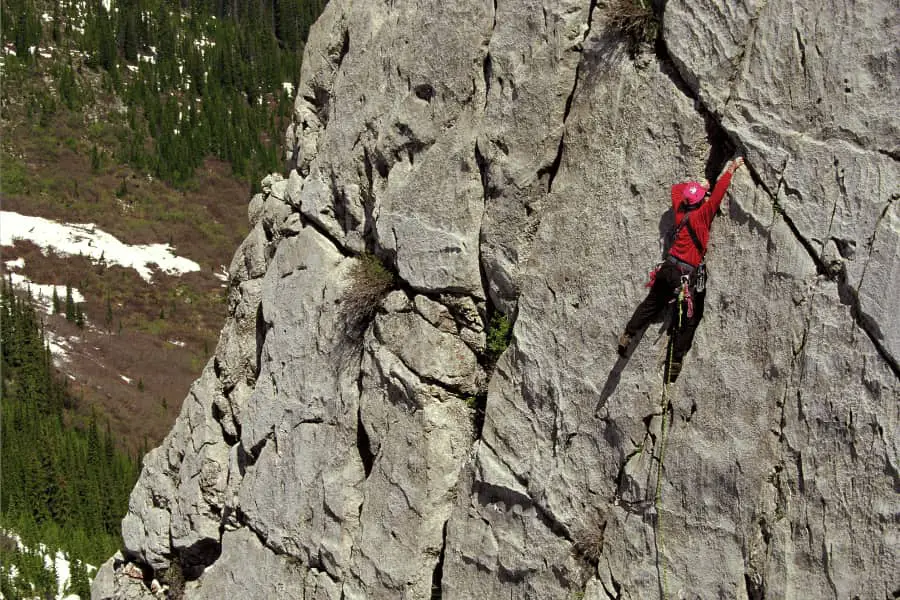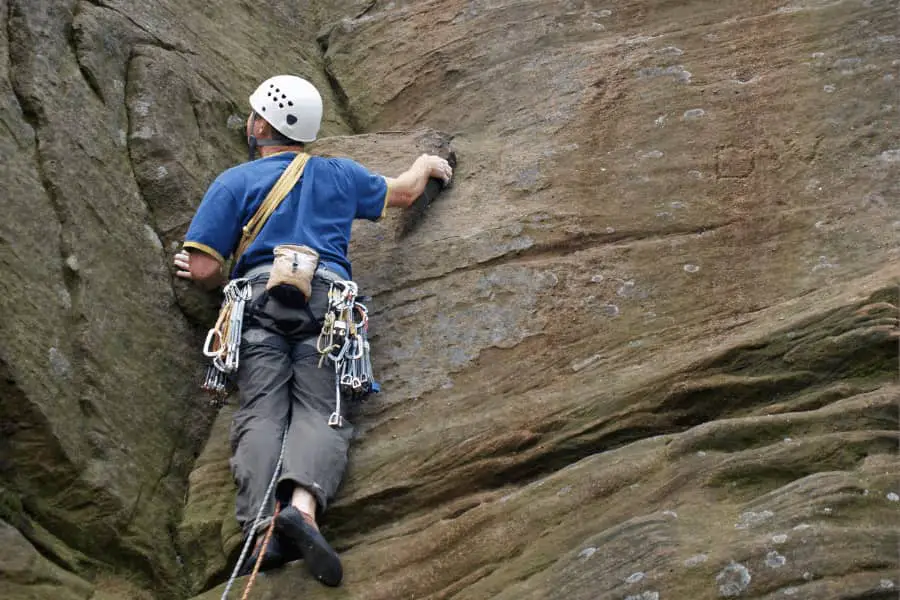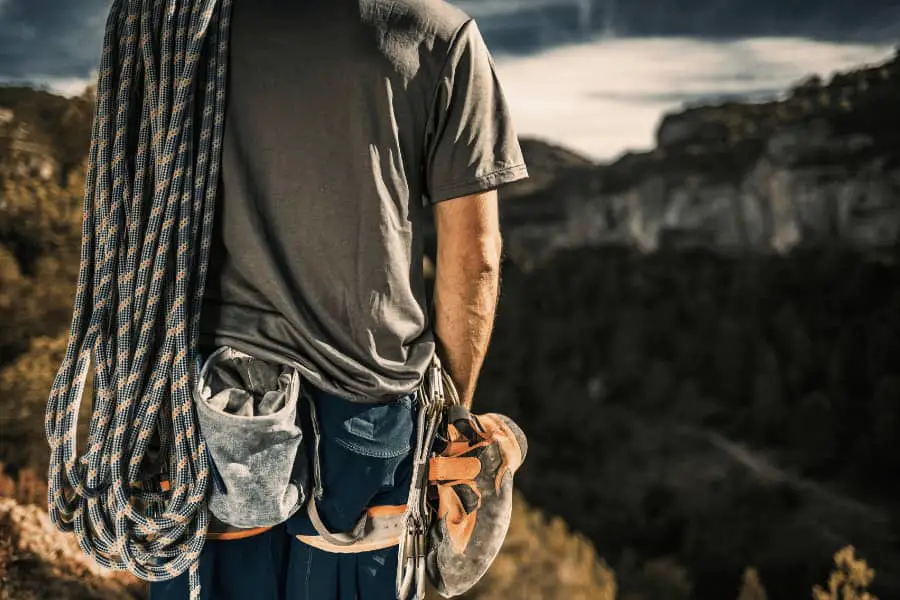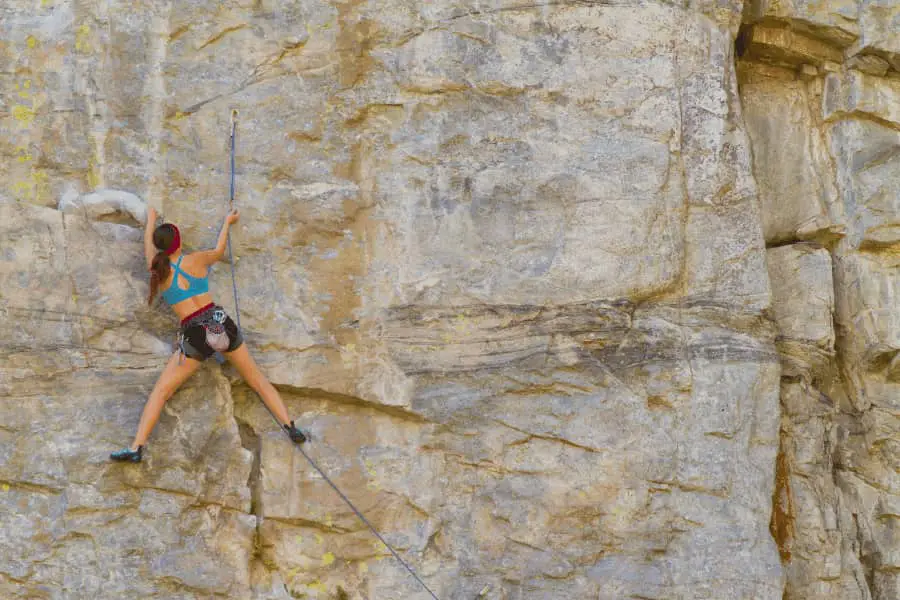
Sport climbing can be very difficult to get good at. In fact, I was terrible at sport climbing when I was first transitioning to it from top rope and bouldering. Sport climbing adds extra elements that challenges your mental and physical climbing abilities. Keeping track of all of these extra elements can be difficult, especially when you are first starting to get into sport climbing.
The 12 tips below are things I picked up along my sport climbing journey that I wish I would have known from the get-go.
If you are just starting to sport climb or have been sport climbing for a little while now, the following 12 tips and tricks will help you take your climbing abilities to the next level.
If you are interested in seeing what the current prices are for the most popular rock climbing training aids, you can find them on Amazon by clicking here. Using the Amazon affiliate link above and/or other links in the article helps support this website.
1. Improve Your Clipping Abilities
This can’t be overstated. Being able to clip efficiently will greatly increase your sport climbing ability. Clipping quickly and correctly will decrease the amount of time on the wall that you are not climbing. That is the golden rule in sport climbing: either be resting or climbing (and nothing else). Do not be on the wall fumbling about trying to clip into the draw.
The longer it takes you to clip, the longer you will have to hold yourself on the wall with one less arm. The longer you have to do that, the more tired you become. By decreasing the amount of time it takes you to clip, you also decrease the amount of energy and effort you have to exert to stay onto the wall.
In an effort to counteract this, you can become a clipping master. To do this, make sure you are using the correct clipping technique and are able to clip into draws that have the gate facing you and away from you. Not every gate will be perfectly positioned.
My favorite way to practice clipping is to place a quickdraw on the rear view mirror of my car. This allows me to practice clipping a rope into the draw when I pull up at a red light. The next day I will change the draw’s direction i.e. if the gate was towards me one day, it would be away from me the next. Doing this helps me maximize my time not climbing.
You will come to learn that climbing is all about efficiency, and doing this greatly increases that. If you are stopped at a red light doing nothing, might as well get some clipping practice in. Just be sure to notice when the light turns green. Otherwise you will some annoyed drivers behind you.
2. Learn How To No-Hands Rest
Resting with no hands is one of the most underrated aspects of sport climbing. As mentioned above, you either want to be climbing or resting. The ability to rest with no hands is a must learn for all sport climbers.
Resting while on a jug or another good hold allows you to shake out one arm at a time. Alternating your arms will allow you to get decent rest for both of them. It doesn’t however allow you to leave the hold completely fresh. No matter what, the arm you were using to hold yourself onto the wall last will be tired to some degree.
Finding a way to rest without using your arms will negate that issue. It will allow you to shake out both arms at once and allow both of them to be completely fresh for when you start climbing again.
The easiest way to no-hands rest is to find a fat ledge and stand or sit on it. I recommend to stand and not sit down. I have found that when I sit down in the middle of the route, it can be hard to get climbing again (especially when you are already exhausted). Another easy way to rest is to find two really good foot holds and balance on them. This works the best when climbing slabs where you really lean into the wall or in corners. Corners allow you to push against both sides of the wall and get really nice footing to stand on.
More advanced (and much cooler looking) no-hands resting techniques include bat hangs and kneebars.
- Bat hangs involve using your feet to hook yourself into a ledge on the rock and hang upside down like a bat. These are incredibly hard (and dangerous) to perform but look extremely sick.
- Kneebars involve lodging your leg (the portion between the bottom of your foot and the top of your knee) into the wall or large holds. Certain kneebars will support your entire weight and will allow you to no-hands rest.
3. Know When To Rest And When To Keep Climbing

Not listening to your body is one of the quickest ways to fall off of a sport climbing route.
If you feel yourself getting pumped and come to a good potential resting spot but just keep going … you wont get very far past that. On the other hand, if you are feeling strong and come up on a potential resting spot, there really is no need to stop there.
One of the things I kept doing at the start of my sport climbing journey was stopping to rest when I didn’t need to. This caused me to be on the wall longer than I needed to. Once I stopped taking unnecessary rests, I was able to send routes I was previously unable to consistently.
Although taking an unnecessary rest doesn’t seem like a big deal, you are actually spending energy when you are resting. The goal of sport climbing is to get tot the top using the least amount of energy as possible. So if you don’t absolutely need to rest to get through the next part of the climb, skip that rest and keep climbing.
Sending long sport routes becomes a lot easier once you are able to determine when a rest would actually be beneficial to you or not. Keeping this in mind during your attempt is one of the many mental aspects of sport climbing.
4. Improve Your Climbing Efficiency
Sport climbing routes can be long and grueling. This is in stark contrast with bouldering routes that require very short but intense energy bursts.
Having good climbing technique will help you conserve energy and will keep you climbing for longer. Although you may be strong enough to perform certain moves without perfect technique, this will wear you out quicker than if you had good technique.
Finding the easiest way to perform a move will be incredibly beneficial for you when transitioning to sport climbing. My favorite way to find the best way to perform moves (besides watching youtube videos) was to pick a set of moves each session and try to climb them at least 5 different ways. This allowed me to develop a better mind-muscle connection with my body.
Remember to always propel yourself up the wall with your legs and try to stay as close to the wall as possible. Using proper footwork and body positioning will help you save a ton of energy on these long sport climbing routes.
5. Use The Right Pace When Climbing
Climbing at the right pace in different parts of the route will help you save your energy for the parts you will need it the most. In a way, sport climbing is oddly similar to chess. You need to plan out your moves before they happen to be great at it.
If you are taking your time and climbing slow in in the crux, you will spend a lot more energy than you need to. This will leave you pumped and exhausted for the rest of the route.
On the other hand, if you are climbing fast in technically hard areas that are easier physically, you are spending more energy than you should. This will leave you gassed when you get to the crux.
Finding the right pace for each part of the route will help you conserve energy and send these longer routes with more consistency.
6. Find A Sport Climbing Mentor
Mentors play key roles in everyone’s lives no matter what subject they are a mentor for. Having someone helping you out who has been where you are and has accomplished what you set out to do can be incredibly helpful for every part of life (climbing included).
An experienced sport climbing mentor will be able to walk you through the ins and outs of sport climbing like nothing else. Although I wish to be a positive influence and help you along in you climbing journey, there is only so much I can help you with from behind a computer. Having a mentor out climbing with you will be an invaluable resource.
A sport climbing mentor will be able to help you master every aspect of sport climbing. They can give you tips on how to climb more efficiently, how to pace yourself better, and help you learn when to take rests. On top of this, they can help you assimilate better into the climbing culture by helping you learn cool climbing slang, proper crag etiquette, and how to represent the climbing community correctly.
If you have a chance to find a sport climbing mentor, definitely go for it! I recommend searching one out if you haven’t met one yet. They have a chance to become a big part of your climbing life.
7. Get The Right Climbing Gear

Sport climbing requires more (and different gear) than top rope and bouldering. That means there are more things to consider when picking out what gear you would like to get. Below you
- Climbing Shoes – you generally will want a pair of shoes that are stiffer than bouldering shoes. You will be climbing for longer periods of time and will need to provide your feet with some support when sport climbing.
- Harness – unless you are planning to on sight or flash incredibly hard climbs and need to save every ounce of weight, you will not need a very expensive, very advanced harness. I recommend getting an all-around harness that is comfortable and will last you many years to come.
- Chalk bag – I prefer to sport climb with a chalk bag that has very easy access so I don’t have to fumble around with getting my hand into it. My favorite bag has a wide mouth, can be opened with one hand and sits on me perfectly.
- Rope – the same statement made with the climbing harness above applies to the rope as well. Having a durable, all-around rope will be more than sufficient for your general sport climbing needs. The more expensive and incredibly thin/lightweight rope comes into play for very advanced climbers trying to set personal records.
- Quickdraws – the same reasoning applies to draws as it did with the harness and rope. There is no need to get incredibly light quickdraws unless you are trying to make every last ounce count.
- Helmet – although some climbers do not wear helmets (like myself), I do recommend to put safety first and to wear one. If you are looking for a sport climbing helmet, I recommend getting a shelled foam helmet. These are little bit more expensive but are drastically cooler, lighter, and more comfortable than the cheaper, hardshell helmets.
- Approach Shoes – honestly any hiking/athletic shoes will work. I recommend wearing something that is comfortable and will provide you with good ankle support and traction for maneuvering your way to the crag. It really sucks rolling your ankle or slipping on a boulder and spraining your wrist before you even get to the crag. A good pair of approach shoes will help prevent that.
I have a recommended gear page where I detail in depth what gear I recommend and why. I have tried out many different products when I worked for REI and have extensive knowledge in the world of climbing gear. Buying the most expensive gear is definitely not always worth it. You can check out my recommendations here. Most of my recommendations are relevant to the sport climbing world and fit the features listed above.
8. Learn The Different Sport Climbing Terms
Climbing is a lifestyle and as such, has its own language. By now you have most likely heard and used some of the popular climbing terms by now. Some of the most commonly used lingo in sport climbing is:
- belay
- beta
- bolt
- bolted route
- bomb proof
- flash
- grigri
- onsight
- redpoint
- runout
- take
- whipper
Familiarizing yourself with these terms and what they mean will help you out in your first day at the crag with other climbers. To learn more about these climbing terms and other popular climbing lingo, I recommend checking out REI’s article linked here. It goes over all of the terms listed above and many more!
9. Learn Proper Crag Etiquette
Proper crag etiquette is composed of the following 9 rules:
- Leave no trace.
- Don’t be too loud.
- Be respectful to other climbers.
- Minimize the amount of space you take up.
- Be patient if other climbers are on the route you want to send.
- Don’t share beta unless asked to.
- Don’t remove draws from a route.
- Keep the temper tantrums to a minimum.
- Don’t bring your dog if it barks a lot or you won’t pick up after it.
In short, don’t be a prick. When you go climbing at the crag, make sure you are being respectful to nature and to other climbers/groups around you.
The climbing community is awesome and I believe it to be a very positive influence on the world. It is so awesome because climbers are welcoming, respectful, and happy to help everyone out that is going about things the right way. Part of this stems from practicing proper crag etiquette. Climbers that disrespect nature and other climbers around them do not properly represent the lifestyle that climbing was founded on.
Although there is not definite, agreed-upon set of rules when climbing, keep in mind the proper crag etiquette listed above and try to give everyone involved a positive climbing experience.
10. Keep The Rope Between You and The Wall

This tip is important for the unwanted (but common) outcome of sport climbing: falling. Falling with the rope behind you and not in between you and the wall can be extremely dangerous.
The rope can catch onto one of your body parts and get you tangled up when falling. This is a very easy way to get seriously injured. The best way to prevent this is to always make sure the rope is inside of your body and between you and the wall.
One of the main facets of climbing is keeping yourself safe and uninjured. This allows you to keep climbing and not have to take anytime off. Not only do you get to climb more, you avoid potentially expensive hospital bills. Always make sure the rope is between you and the wall.
11. Overcome Your Fear Of Falling
When transitioning into sport climbing, it can be nerve wrecking to take 10-20 foot free falls until your gear (and belayer) catch you. This definitely takes some practice at to get comfortable with for most climbers.
If you are constantly afraid of falling, focusing on the next clip, and how far you are above your last clip, you will not be able to fully concentrate on the climb. You will be too caught up in what comes next in relation to the clips rather than what is coming up in the climb.
As discussed above, sport climbing is just as much of a mental game as it is a physical one. Concentrating on anything outside of the climb will not allow you to climb at your best. Sport climbing is chess, and focusing on what color the chair is you are sitting on will not help you win the chess game.
The best way to get over your fear of falling is to learn the proper falling technique and to practice it by starting small and gaining comfort with taking a fall. To learn more on how to do this, I recommend you check out the article I wrote linked here. It goes into great detail on how to get over your fear of falling and gives 10 very helpful tips to do so.
12. Improve Your Belaying Ability
Although belaying is not the flashy part of being a sport climber, it comes with the territory. Unless your partner is someone who only wants to belay and has no interest in climbing (extremely unlikely), you will have to spend some of the session belaying them.
Becoming a better belayer will help you give your partner a better climbing experience and will help you keep your climbing partner. Nobody wants to be caught hard every time they fall. That can get old very quick.
Learning how to become a better belayer will help keep your partner in good spirits and will lend itself to a more productive and more fun session for everyone involved.
The bottom line? Sport climbing is just as much of a mental exercise as it is a physical one. Learning how to rest, when to rest, and how to climb efficiently are integral in becoming a great sport climber. Familiarizing yourself with and using proper lingo and crag etiquette will help you fit into the climbing community when going sport climbing outside for the first time. Be sure to keep in mind that a sport climbing mentor can be an invaluable resource in your climbing journey.
